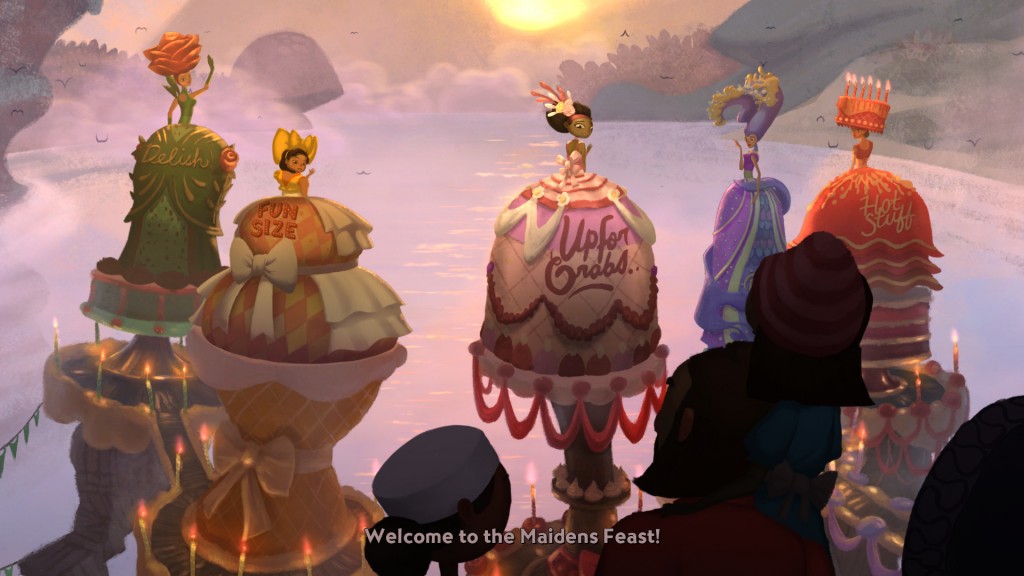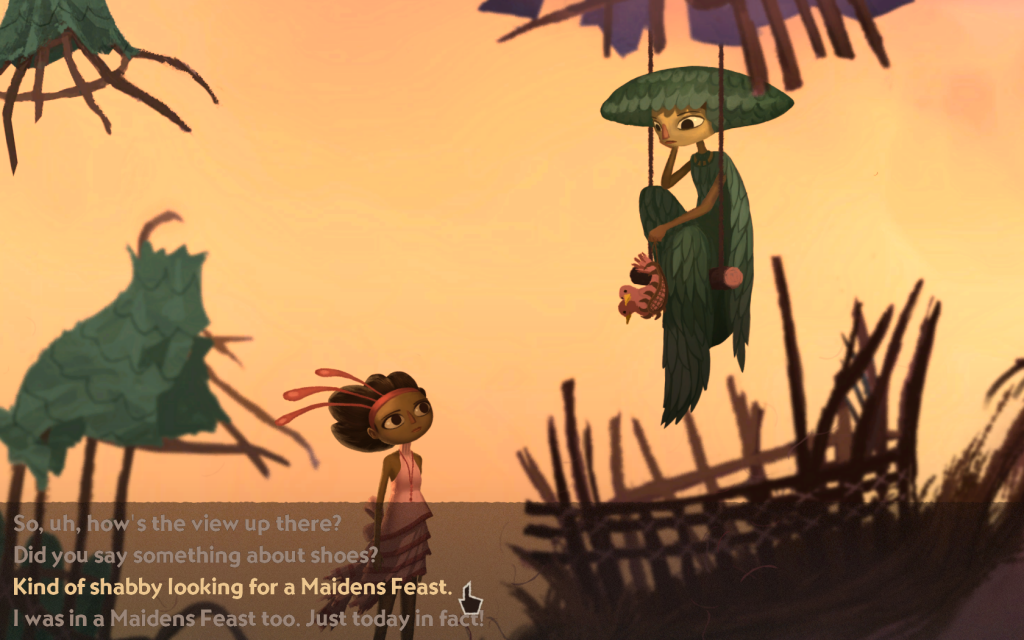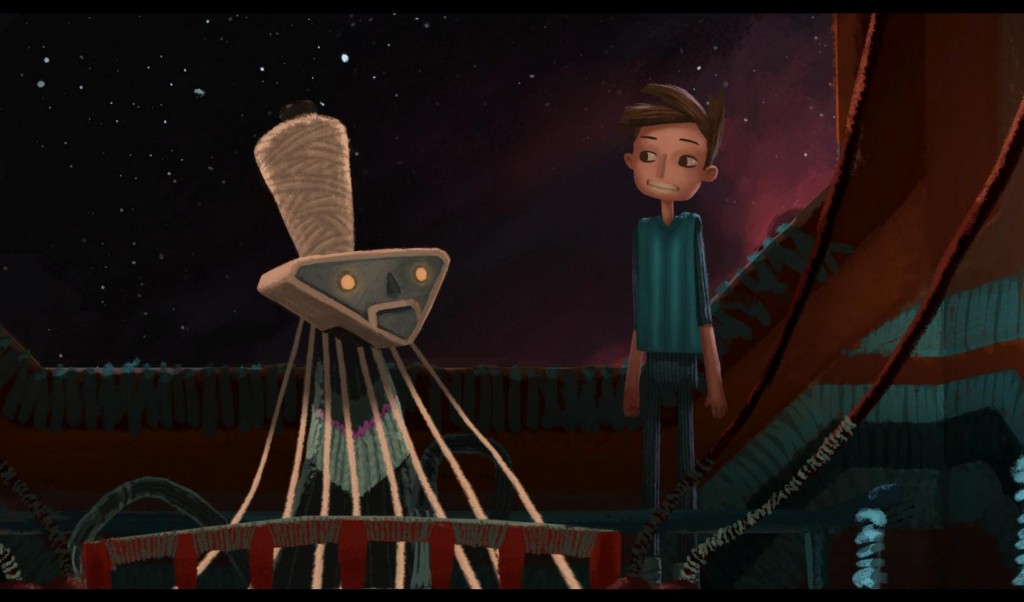There has always been something special about the way Tim Schafer approaches games, or at least about the way they turn out. His knack for bringing great narratives, wonderful characters, and fantastical elements to what seems to be mundane made a fan out of me from a very early age.And so I was excited when I heard about his Kickstarter, but also wary. Anyone who has followed Schafer’s career to any degree can tell you that there are a lot instances in his games where it was evident that content was cut in the name of time or funds. The best example, perhaps, is the third army in Brutal Legend, which is used only once. It came as no surprise to me then, when it was announced Broken Age would be split into two parts. I have a few theories on what happened, but that is not why we are here. We are here to see if Broken Age Act 1 is any good.
Broken Age claims it is an old school point and click adventure game, but that is not entirely accurate. It is a streamlined version of an old school adventure game. Instead of a menu of verbs or actions like you would see in a game like Day of the Tentacle, or the verb wheel in Full Throttle, there are really four actions you can perform in Broken Age. You can click on things on the screen which will cause the characters to interact (or not) with what you clicked. You can open a menu and observe the items in your inventory. You can combine the items in your inventory, and you can click and drag the items to the main game screen to use them on other objects in the world. While I understand that the streamlining might displease some purists, the change was barely noticeable during game play. All it really does is eliminate the instances where you “click on a verb, then click on everything” by eliminating the step where you click on the verb.
Perhaps what makes the exclusion of a verb system less evident is the difficulty of the game. Managing difficulty in an adventure game is particularly tricky, because at the end of the day it boils down to the difficulty of puzzles where you are asking the player to follow as specific logical thread that will result in the desired effect. This could lead to making the difficulty seem artificial and frustrating rather than challenging and rewarding. On the other end of the spectrum, an adventure game that follows a more mainstream line of logic will be too easy, because everyone expects that using a key on a locked door will unlock it. Broken Age leans towards the latter side of the spectrum. There are no great leaps in logic to how the puzzles are solved. While I can’t speak for everyone, this made me breeze through the game, having only two separate occasions where I had to wonder a bit touching random things. The lack of difficulty means that a game that is not very long, to begin with, feels even shorter.
While it does last, though, Broken Age is a terrific experience that reminds old time fans of point and click adventure games, why they love the genre. The first thing that becomes apparent when you boot up Broken Age is just how pretty it is. With hand painted backgrounds and characters that are beautifully animated, it really feels like you are playing inside an oil on canvas work in a museum. The voice acting too, is top notch, which is not surprising. The cast of voice actors includes Elijah Wood, Jack Black, Mesasa Moyo, Wil Wheaton, Pendelton Ward (he of Adventure Time fame), and the ever present Jennifer Hale. The cast brings their A game to this production, bringing to life the excellent dialogue. Clever, well written, creative, funny when appropriate and as always, quirky, the dialogue in Broken Age is on par with the best Schafer and his teams have made in any of their games. To hear it acted so well and in a game that’s so visually stunning, is nothing short of a treat.
The plot, fortunately, holds up to the quality put forth by the rest of the game. You will play to parallel stories, the first being the story of Vella, a maiden who was selected for the great honor of the Maiden’s Feast: a tradition in which the best maidens of the villages are fed to a monster known as Mog Chothra, who in exchange for the blood offering, spares their village for 14 years. Vella is not thrilled by this honor, and wonders if there is a way to fight the monster rather than just placate it. The other story features Shay, a teenager who lives in a space-ship, alone with a motherly AI who does its best to try to keep him entertained. However, Shay is getting older, and getting bored of the safety of his routine, and wonders what is out there. It is appropriate that the plot of the game that simultaneously proved that there is still a market for adventure games, and also kicked off the trend of gaming legends using Kickstarter to fund their pet projects would emphasize questioning the status quo and breaking out of your routine. Through Vella’s story you hear the refusal of everyone to lend help because that’s the way things were and there is no reason to change it. Some even go as far as to being offended at the mere suggestion of harming Mog Chothra. Shay is trapped in a cycle of routine, and is ready to start exploring what lies beyond the boundaries he has known since he was a child.
You can change between the two characters at any time. The two stories are not connected until the very end, but I appreciated the opportunity to switch back and forth to break the flow. The mechanic encourages you to try to guess how Vella and Shay are connected. It served, at least in my case, as a very effective tool of misdirection. When the stories finally collide they do so in a spectacular fashion. It changes the story in a way that makes you look upon the events of the story thus far in a new light. A light that calls into question your activities up to that point shows you that you understand even less than you imagined.
And then it ends. Leaving you to wonder just what will happen next, while uncomfortably measuring the implications of the things you witnessed as you played, and asking just when part two will come out. If anything, this is both a recommendation and a warning. The game is fantastic, especially if you are fan of point and click adventure games and Tim Schafer’s work in general, but it will leave you waiting for part two in the worst kind of way. Of course, If you are really a die-hard Tim Schafer fan, you’ve probably already purchased it, finished it, written a detailed walkthrough for it, and played through it again to see all the funny quips you missed the first time around. For the rest, I’d recommend picking it up only if you think you will have the fortitude to bear the wait for part 2.








